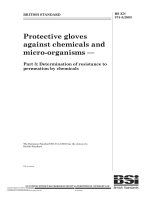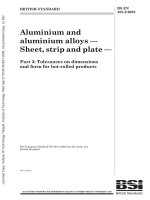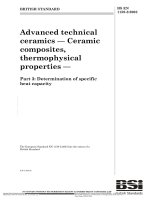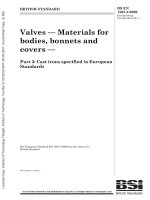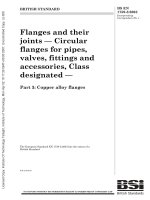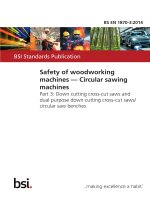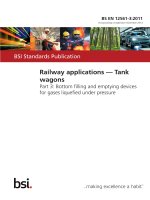Bsi bs en 14175 3 2003 (2014)
Bạn đang xem bản rút gọn của tài liệu. Xem và tải ngay bản đầy đủ của tài liệu tại đây (954.67 KB, 34 trang )
BRITISH STANDARD
BS EN
14175-3:2003
Incorporating
corrigendum
February 2014
Fume cupboards —
Part 3: Type test methods
ICS 71.040.10; 91.140.30
BS EN 14175-3:2003
National foreword
This British Standard is the UK implementation of EN 14175-3:2003. Together
with BS EN 14175-1:2003, BS EN 14175-2:2003, BS EN 14175-4:2004,
DD CEN/TS 14175-5:2006, BS EN 14175-6:2006 and BS EN 14175-7:2012,
it supersedes BS 7258-1:1994, BS 7258-2:1994, BS 7258-3:1994 and
BS 7258-4:1994 which are withdrawn.
The UK committee advises that prior to purchasing a fume cupboard, a risk
assessment should be performed to assess the risks associated with the
substances that are to be manipulated. This would ensure that the fume
cupboard is suitable for its intended purpose and that current exposure
limits for toxic substances are not exceeded. It is suggested, therefore, that
users may need to draw up a specification appropriate to their particular
requirements, within the overall permissible limits of this standard and the
information on installation included in the National Annex. For users with
little experience of purchasing fume cupboards, it may be helpful for trade
associations, employers’ bodies or other organizations associated with a
particular activity to give guidance on a suitable specification. An example
would be Building Bulletin 88 from the Architects & Building Branch of the
Department for Education and Employment, which is currently under revision
and to be published in future as G9a Fume Cupboards in Schools by
CLEAPSS.
The UK participation in its preparation was entrusted by Technical Committee
LBI/1, Laboratory safety and equipment to subcommittee LBI/1/1, Laboratory
furniture and fittings.
A list of organizations represented on LBI/1/1 can be obtained on request to its
secretary.
This publication does not purport to include all the necessary provisions of a
contract. Users are responsible for its correct application.
Compliance with a British Standard cannot confer immunity from
legal obligations.
This British Standard was
published under the authority
of the Standards Policy and
Strategy Committee
on 30 March 2007
© The British Standards
Institution 2014. Published
by BSI Standards Limited
2014
ISBN 978 0 580 84309 9
Amendments/corrigenda issued since publication
Date
Comments
28 February 2014
Correction to supersession details and national
foreword
EN 14175-3
EUROPEAN STANDARD
NORME EUROPÉENNE
EUROPÄISCHE NORM
December 2003
ICS 71.040.10
English version
Fume cupboards - Part 3: Type test methods
Sorbonnes - Parite 3: Méthodes d'essai de type
Abzüge - Teil 3: Baumusterprüfverfahren
This European Standard was approved by CEN on 1 October 2003.
CEN members are bound to comply with the CEN/CENELEC Internal Regulations which stipulate the conditions for giving this European
Standard the status of a national standard without any alteration. Up-to-date lists and bibliographical references concerning such national
standards may be obtained on application to the Management Centre or to any CEN member.
This European Standard exists in three official versions (English, French, German). A version in any other language made by translation
under the responsibility of a CEN member into its own language and notified to the Management Centre has the same status as the official
versions.
CEN members are the national standards bodies of Austria, Belgium, Czech Republic, Denmark, Finland, France, Germany, Greece,
Hungary, Iceland, Ireland, Italy, Luxembourg, Malta, Netherlands, Norway, Portugal, Slovakia, Spain, Sweden, Switzerland and United
Kingdom.
EUROPEAN COMMITTEE FOR STANDARDIZATION
COMITÉ EUROPÉEN DE NORMALISATION
EUROPÄISCHES KOMITEE FÜR NORMUNG
Management Centre: rue de Stassart, 36
© 2003 CEN
All rights of exploitation in any form and by any means reserved
worldwide for CEN national Members.
B-1050 Brussels
Ref. No. EN 14175-3:2003 E
EN 14175-3:2003
Contents
page
Foreword......................................................................................................................................................................3
Introduction .................................................................................................................................................................4
1
Scope ..............................................................................................................................................................5
2
Normative references ....................................................................................................................................5
3
3.1
3.2
3.3
Terms and definitions....................................................................................................................................5
plane of sash ..................................................................................................................................................5
inner measurement plane .............................................................................................................................5
containment factor (CF) .................................................................................................................................6
4
4.1
4.2
4.3
4.4
Test room and general test conditions........................................................................................................6
Dimensions and construction ......................................................................................................................6
Test room conditions ....................................................................................................................................6
Fume cupboard installation ..........................................................................................................................6
Test conditions ..............................................................................................................................................6
5
5.1
5.2
5.3
5.4
5.5
5.6
Air flow tests...................................................................................................................................................7
Extract volume flow rate ...............................................................................................................................7
Face velocity...................................................................................................................................................7
Containment ...................................................................................................................................................8
Robustness of containment........................................................................................................................14
Air exchange efficiency...............................................................................................................................15
Pressure drop...............................................................................................................................................17
6
6.1
6.2
6.3
6.4
Sash tests .....................................................................................................................................................17
Sash suspension test ..................................................................................................................................17
Sash displacement test ...............................................................................................................................18
Protection against splashes .......................................................................................................................18
Sash stop and alarm test ............................................................................................................................18
7
Air flow indicator tests ................................................................................................................................18
8
Construction and materials tests ...............................................................................................................18
9
Illuminance test ............................................................................................................................................18
10
Test report ....................................................................................................................................................18
Annex A (informative) Sound tests..........................................................................................................................20
National annex NA (informative) Recommendations for the exchange of information and
recommendations for installation .............................................................................................................22
Bibliography ..............................................................................................................................................................21
2
EN 14175-3:2003
Foreword
This document (EN 14175-3:2003) has been prepared by Technical Committee CEN/TC 332 “Laboratory
equipment”, the secretariat of which is held by DIN.
This European Standard shall be given the status of a national standard, either by publication of an identical text or
by endorsement, at the latest by June 2004, and conflicting national standards shall be withdrawn at the latest by
June 2004.
Annex A is informative.
This European Standard EN 14175 consists of the following parts, under the general title Fume cupboards;
Part 1: Vocabulary
Part 2: Safety and performance requirements
Part 3: Type test methods
Part 4: On-site test methods
Part 5: Recommendations for installation and maintenance (in preparation)
Part 6: Variable air volume fume cupboards (in preparation)
According to the CEN/CENELEC Internal Regulations, the national standards organizations of the following
countries are bound to implement this European Standard: Austria, Belgium, Czech Republic, Denmark, Finland,
France, Germany, Greece, Hungary, Iceland, Ireland, Italy, Luxembourg, Malta, Netherlands, Norway, Portugal,
Slovakia, Spain, Sweden, Switzerland and the United Kingdom.
3
EN 14175-3:2003
Introduction
The objective of this European Standard is to specify type test methods relevant to the assessment of the safety
and performance of fume cupboards.
4
EN 14175-3:2003
1
Scope
This part of the European Standard EN 14175 specifies type test methods for the assessment of safety and
performance of fume cupboards. Relevant requirements are specified in Part 2 of this European Standard.
For terms and their definitions EN 14175-1 applies. For safety and performance requirements of fume cupboards
EN 14175-2 applies.
NOTE
For on-site test methods of fume cupboards, Part 4 of this European Standard is in preparation.
For the testing of microbiological safety cabinets EN 12469 applies.
2
Normative references
This European Standard incorporates by dated or undated reference, provisions from other publications. These
normative references are cited at the appropriate places in the text and the publications are listed hereafter. For
dated references, subsequent amendments to or revisions of any of these publications apply to this European
Standard only when incorporated in it by amendment or revision. For undated references the latest edition of the
publication referred to applies (including amendments).
EN 12665, Light and lighting — Basic terms and criteria for specifying lighting requirements.
EN 13150:2001, Workbenches for laboratories — Dimensions, safety requirements and test methods.
EN 14175-1:2003, Fume cupboards — Part 1: Vocabulary.
EN 14175-2:2003, Fume cupboards — Part 2: Safety and performance requirements.
EN ISO 5167-1, Measurement of fluid flow by means of pressure differential devices inserted in circular crosssection conduits running full — Part 1: General principles and requirements (ISO 5167-1:2003).
EN ISO 12569, Thermal insulation in buildings — Determination of air change in buildings — Tracer gas dilution
method (ISO 12569:2000).
3
Terms and definitions
For the purposes of this European Standard, the definitions given in EN 14175-1:2003 and the following apply.
3.1
plane of sash
plane in the middle between the innermost and the outermost screen surfaces of that part of the sash forming the
upper boundary of the test sash opening.
NOTE
This definition replaces the definition given in EN 14175-1:2003, 5.4.
3.2
inner measurement plane
plane of sash at the type test opening, except where the plane of sash does not meet the work surface of the fume
cupboard. In the latter case, it is usually a non-vertical plane bounded;
at the top by the lowest point of the upper edge of the type test opening in the plane of the sash;
at the bottom by the uppermost point of the lower edge of the opening closest to the plane of sash;
5
EN 14175-3:2003
at the sides by the side edges of the opening.
NOTE 1
See examples in Figures 1 and 2.
NOTE 2
This definition replaces the definition given in EN 14175-1:2003, 7.7.
3.3
containment factor (CF)
ratio of calculated concentration of tracer gas in the work space of the fume cupboard to the measured
concentration in the inner or outer measurement plane.
NOTE
The containment factor is no constant value but depends on the extract volume flow rate and the measured
concentration of tracer gas.
4
Test room and general test conditions
4.1
Dimensions and construction
The test room shall consist of an enclosure of cuboid shape, constructed of suitable materials, within an existing
building or laboratory. The internal width and length shall be not less than 4,0 m and the ceiling height not less than
2,7 m. The ceiling and floor shall be level and the room shall be devoid of internal supports, internal walls or other
obstacles to the airflow.
4.2
Test room conditions
The room air temperature shall be (23 ± 3) °C. The make-up air temperature during measurements shall be room
air temperature ± 1 °C. Temperature gradients shall be avoided to the greatest possible extent. The make-up air
shall be supplied at a distance greater than 2 m from the front of the fume cupboard.
The test zone boundary shall extend approx. 1,5 m in front of the fume cupboard and approx. 1,0 m from the outer
sidewalls of the cupboard over the full room height.
Room extract air shall be extracted symmetrically on the opposite side to the make-up air supply and from outside
the test zone. The air speed shall be less than 0,1 m/s at the test zone boundaries. Care shall be taken regarding
uncontrolled air streams and draughts entering into the test room.
Any device the temperature of which exceeds 40 °C, except components which form part of the fume cupboard
and/or the test equipment, shall be located outside the test zone boundaries.
The air extracted from the test room shall be discharged to atmosphere in such a way as to prevent its reentrainment in the make-up air.
4.3
Fume cupboard installation
The fume cupboard shall be installed centrally on a wall with its back to the wall.
The test shall be carried out on the fume cupboard installed in the test room in accordance with the manufacturer's
installation instructions.
4.4
4.4.1
Test conditions
General
No person other than the operator(s) shall be present in the test room during the measurements. No person shall
remain in the test zone during the measurements.
6
EN 14175-3:2003
There shall be no unnecessary obstructions or equipment within the test zone. No equipment other than that
necessary for the tests shall be in the fume cupboard.
Windows and doors of the test room shall remain closed during measurements.
NOTE
Observance of all test conditions is crucial for reproducibility and comparability of the test results.
4.4.2
Test sash positions
4.4.2.1
Vertical sash fume cupboards
The sash shall be set to the height of 500 mm ± 1 % measured in the center of the opening. If the maximum height
is less than 500 mm, the maximum operational sash opening shall be used and noted. If any additional opening is
used, this shall be noted in the test report.
4.4.2.2
Horizontal sash fume cupboards
Sash(es) shall be set at one side opening of 500 mm ± 1 %. If the maximum sash opening is less than 500 mm,
then the maximum opening shall be used and noted. The test shall be carried out with the first side opening and
shall be repeated with the opening at the other side. If any additional opening is used, this shall be noted in the test
report.
4.4.2.3
Combination sash(es)
Vertical sash test: all horizontal sash(es) shall be set to the minimum sash opening and the procedure as in 4.4.2.1
shall be followed.
Horizontal sash test: vertical sash(es) shall be set to the minimum sash opening and the procedure as in 4.4.2.2
shall be followed.
If any additional opening is used, this shall be noted in the test report.
4.4.3
General procedure
The type testing procedures shall be applied to one example of a production model of the fume cupboard to be
tested.
Adjust the make-up air and extract air systems to give the required flow rates and test conditions. Switch on all
instruments and data recording (storing) device(s), and allow sufficient time for the instruments to stabilise.
5
Air flow tests
5.1
Extract volume flow rate
For each extract volume flow rate setting, the flow rate shall be measured in the extract duct in accordance with EN
ISO 5167-1. The uncertainty of measurement shall not exceed ± 5 %.
5.2
Face velocity
5.2.1
5.2.1.1
Test equipment
Anemometer
The anemometer shall be of the unidirectional type with a directional sensitivity of ± 20°. The time constant of the
anemometer shall be less than 0,5 s. The uncertainty of an individual measurement shall not exceed 0,02 m/s + 5
% of the reading in the range of 0,2 m/s to 1,0 m/s. An anemometer with a valid calibration certificate shall be used.
7
EN 14175-3:2003
5.2.1.2
Data recording
A means of recording the output of the anemometer for subsequent analysis shall be provided.
5.2.2
Probe positions
The anemometer probe shall be positioned at points formed by the intersection of lines on the inner measurement
plane (see examples in Figure 1) as follows:
a)
a series of at least three equally spaced lines between the side boundaries of the inner measurement plane
with the two outermost lines (100 ± 5) mm from the side boundaries. The lines in between shall be at a
distance of 400 mm or less from the outermost lines and to each other.
b)
a series of at least three equally spaced lines between the horizontal boundaries of the inner measurement
plane with the two outermost lines (100 ± 5) mm from the horizontal boundaries. The lines in between shall be
at a distance of 400 mm or less from the outermost lines and to each other.
5.2.3
Test procedure
Measurements shall be made with the anemometer probe located at each of the measurement grid points. Adjust
the orientation of the sensor so that its measurement direction is perpendicular to the inner measurement plane.
Disturbances to the space upstream of the sensor shall be minimised.
Measure and record the individual velocity component vi perpendicular to the inner measurement plane at regular
intervals of 1,0 s or less for a period of at least 60 s.
5.2.4
Data analysis and results
Calculate at each measurement point by equation (1) the mean value
v of the measured velocity components vi in
meter per seconds and round the result to the second decimal place:
1
n
v=
n
∑
vi
i =1
(1)
where n is the number of measurements taken during the period of min. 60 s.
Calculate at each measurement point by equation (2) the standard deviation
components
s r of the measured velocity
vi in meter per seconds and round the result to the second decimal place:
∑ (v
n
sr =
i =1
i
−v
n −1
)
2
(2)
Calculate the spatial average velocity (see EN 14175-1:2003, 7.6) in meters per seconds at the type test opening
and round the result to the second decimal place.
5.3
Containment
5.3.1
5.3.1.1
Test equipment
General
The following test equipment shall be used. Other equipment and/or test gas may also be used provided that it is
proven to give the same results within ± 10 %. Materials of construction should not effect the test results. All
instruments shall have a valid calibration.
8
EN 14175-3:2003
5.3.1.2
Tracer gas
The tracer gas shall be sulphur hexafluoride (SF6).
5.3.1.3
Test gas
The test gas shall be (10 ± 1) % volume fraction of sulphur hexafluoride (SF6) in nitrogen (N2). The storage
temperature of the test gas shall be at the test room temperature ± 2 °C.
5.3.1.4
Test gas flow regulator
The test gas flow regulator shall be capable of regulating the flow rate with a maximum permissible error of ± 5 %.
5.3.1.5
Test gas injector
The test gas injector shall be a hollow cylinder made of sintered metal with a length between 20 mm and 25 mm
and a diameter between 10 mm and 15 mm. The pressure drop through each test gas injector shall be within 10 %
of their mean value. Test gas injectors shall be connected to the test gas source by flexible tubes of equal length.
5.3.1.6
Sampling probe
Each sampling probe shall consist of a tube of internal diameter (10 ± 1) mm and a length of at least 100 mm. The
tube's wall thickness shall not exceed 2 mm.
5.3.1.7
Sampling manifold
The sampling manifold shall be a hollow cylinder with a minimum aspect ratio (diameter/height) of 10. The sampling
probe connecting tubes shall be evenly distributed around the perimeter of the cylinder with the manifold outlet in
the centre.
5.3.1.8
Connecting tubing
The sampling probes shall be connected to the sampling manifold by flexible tubes of equal lengths.
5.3.1.9
Sampling pump
The sampling pump shall be capable of operating at a flow rate constant within ± 5 %.
5.3.1.10
Gas analyser
-8
The gas analyser including the connected means of recording shall have a detection level of 10 or less volume
fraction of the tracer gas.
5.3.1.11
Time constant of the test system
The time constant of the sampling system including gas analyser shall be less than 15 s.
5.3.1.12
Data recording
A means of recording the output signal of the gas analyser for subsequent analysis shall be provided. The
recording interval shall be 2 s or less.
5.3.2
Test conditions
-8
The background concentration of tracer gas in the test room shall not exceed 10 volume fraction.
9
EN 14175-3:2003
5.3.3
Positioning of test equipment for inner measurement plane
Nine sampling probes (see 5.3.1.6) shall be arranged in a grid formed by the intersection of lines as follows:
a)
three equally spaced lines in the vertical direction. The space between the lines shall be (100 + 5) mm.
b)
three equally spaced lines in the horizontal direction. The space between the lines shall be (100 + 5) mm.
The test gas injector (see 5.3.1.5) shall be arranged with its centre in-line and (150 + 5) mm from the centre of the
sampling probe grid.
The sampling probe grid shall be positioned together with the injector so that the sampling probes are on the inner
measurement plane and the injector is in the workspace of the fume cupboard on a plane (150 + 5) mm from the
inner measurement plane.
Figure 1 and Figure 2 show examples of the positioning of the inner measurement plane for different designs of
fume cupboards.
Key
1
2
inner measurement plane
test sash opening
Figure 1 — Inner measurement plane
10
EN 14175-3:2003
Key
1
2
3
4
5
sash plane
horizontal sashes
sash frame
handle or airfoil
upper reference point
6
7
8
9
10
inner measurement
lower reference point
airfoil
work surface
test sash opening
Figure 2 — Example for exact positioning
The sampling probe grid shall be positioned on the inner measurement plane with its centre probe at points formed
by the intersection of lines as follows:
c)
a series of equally spaced lines between the vertical side boundaries of the inner measurement plane with the
two outermost lines (130 + 5) mm from the vertical side boundaries. Any lines in between shall be at a
distance of 600 mm or less from the outermost lines and to each other.
d)
a series of equally spaced lines between the horizontal boundaries of the inner measurement plane with the
two outermost lines (130 + 5) mm from the horizontal boundaries. Any lines in between shall be at a distance
of 600 mm or less from the outermost lines and to each other.
5.3.4
5.3.4.1
Positioning of test equipment for outer measurement plane
Injector grid
Nine test gas injectors shall be arranged inside the workspace of the fume cupboard on a plane (200 + 5) mm away
from the plane of sash. They shall be positioned with horizontal axis, the test gas flow direction towards the sash
and in a grid formed by the intersection of the following lines:
a)
three equally spaced vertical lines between the two extreme side boundaries of the sash opening with the two
outermost lines (100 + 5) mm from the two extreme side boundaries.
b)
three horizontal lines with the bottom line (100 + 5) mm, the middle line (250 + 5) mm and the top line
(650 + 5) mm above the bottom horizontal boundary of the sash opening.
11
EN 14175-3:2003
5.3.4.2
Sampling probe grid
The sampling probes (see 5.3.1.6) shall be positioned at grid points formed by the intersection of lines on the outer
measurement plane as follows:
a)
a series of equally spaced vertical lines between the side boundaries of the outer measurement plane with the
two outermost lines on the side boundaries. Any lines inbetween shall be at a distance of
400 mm or less from the outermost lines and from each other.
b)
a series of horizontal lines between the horizontal boundaries of the outer measurement plane with the two
outermost lines on the horizontal boundaries and the penultimate lines (200 + 5) mm from the horizontal
boundaries. Any lines in between shall be equally spaced at a distance of 200 mm or less for vertical sashes
respectively 400 mm or less for horizontal sashes from the penultimate lines and from each other.
Figure 3 shows examples of the positioning of the outer measurement plane for four different designs of fume
cupboards.
Key
1
2
outer measurement plane
test sash opening
Figure 3 — Outer measurement plane
Where the plane of the sash does not meet the work surface, the lowest row of sampling probes shall be positioned
(50 ± 5) mm in front of the vertical plane through the front edge of the work surface. If the handle of the sash is
such that it prevents the movement of the sash with the sampling probes in this position, the sampling probes shall
be placed further away but as close as possible to the outer measurement plane. The position of each sampling
probe shall be recorded in the test report.
When low level fume cupboards or walk-in fume cupboards are tested, the test report shall record the height of
positioning of the injector grid and the sample grid. When the test opening exceeds 1000 mm, the distance
between horizontal lines [see b)] may be 400 mm instead of 200 mm.
5.3.5
5.3.5.1
Test procedure
Preparation
Switch on all supply and extract air systems and adjust controls to give specified flow rates. Connect the cylinder of
test gas to the test gas flow regulator and to the test gas injector(s). Connect the sampling probes to the collecting
and analysing system. Switch on suction pumps, the gas analyser and the data recording/storage system and allow
ample time for the instruments to stabilise.
12
EN 14175-3:2003
5.3.5.2
Inner measurement plane test procedure
Set the sash to the test sash opening.
Position the sampling probe grid at one of the test positions.
Turn on the test gas, adjust the flow rate to 2,0 l/min and allow it to stabilise.
Measure and record the tracer gas (SF6) concentration for 360 s.
Stop the injection of the test gas and analyse the data according to 5.3.6.1.
Repeat the test at the same test position for two further times if the mean tracer gas (SF6) concentration exceeds a
-8
volume fraction of 10 during the test period described in 5.3.6.1.
Repeat the test procedure above for other test positions at the same test opening.
Repeat the test procedure above for other test sash openings according to 4.4.2.
5.3.5.3
Outer measurement plane test procedure
Set the sash to the test sash opening.
Turn on the test gas, adjust the flow rate to 4,5 l/min and allow it to stabilise.
Measure and record the tracer gas (SF6) concentration for 780 s.
After a period of 360 s close the sash to its minimum opening in (1
± 0,2) s.
After a further period of 240 s open the sash to the test sash opening in (1
± 0,2) s.
After a further period of 180 s, stop the injection of the test gas and analyse the data according to 5.3.6.2.
Repeat the test for further two times if the mean tracer gas (SF6) concentration exceeds a volume fraction of 10
for any of the test periods described in 5.3.6.2.
-8
Repeat the test procedure above for other test sash openings according to 4.4.2.
5.3.6
5.3.6.1
Data analysis and results
Inner measurement plane data analyses and results
For each test position and test opening analyse the data as follows:
Discard the data for the initial period of 59 s.
Calculate the mean tracer gas (SF6) concentration
round the result to the second decimal place.
1
as volume fraction for the test period from 60 s to 360 s and
Calculate optionally the dimensionless inner measurement Containment Factor CF1 as follows:
CF1 = q (Q × ϕ1 )
(3)
where q is the flow rate of tracer gas (SF6) and Q is the fume cupboard extract flow rate.
Round the CF1 value to the nearest integer and indicate if the result is limited by the detection limit of the
instrument.
13
EN 14175-3:2003
5.3.6.2
Outer measurement plane data analyses and results
For each test opening analyse the data as follows:
a)
Discard the data for the initial period of 59 s.
b)
Calculate the mean tracer gas (SF6) concentration
and round the result to the second decimal place.
2
as volume fraction for the test period from 60 s to 360 s
Calculate optionally the dimensionless outer measurement Containment Factor CF2 as follows:
CF 2 = q (Q × ϕ 2 )
(4)
Round the CF2 value to the nearest integer and indicate if the result is limited by the detection limit of the
instrument.
c)
Calculate the mean tracer gas (SF6) concentration
and round the result to the second decimal place.
3
as volume fraction for the test period from 361 s to 420 s
Calculate optionally the dimensionless outer measurement Containment Factor CF3 as follows:
C F 3 = q (Q × ϕ 3 )
(5)
Round the CF3 value to the nearest integer and indicate if the result is limited by the detection limit of the
instrument.
d)
Calculate the mean tracer gas (SF6) concentration
s and round the result to the second decimal place.
Calculate
follows:
optionally
the
dimensionless
4
as volume fraction for the test period from 421 s to 600
outer
measurement
Containment
Factor
C F 4 = q (Q × ϕ 4 )
C F4
as
(6)
Round the CF4 value to the nearest integer and indicate if the result is limited by the detection limit of
the instrument.
e)
Calculate the mean tracer gas (SF6) concentration
s and round the result to the second decimal place.
Calculate
follows:
optionally
the
dimensionless
5
as volume fraction for the test period from 601 s to 780
outer
measurement
CF 5 = q /(Q × ϕ5 )
Containment
Factor
C F5
as
(7)
Round the CF5 value to the nearest integer and indicate if the result is limited by the detection limit of the
instrument.
5.4
5.4.1
Robustness of containment
Test equipment
The test equipment and its arrangement shall be as described in 5.3.
14
EN 14175-3:2003
In addition a flat rectangular plate with height of (1,90 ± 0,01) m, width of (0,40 ± 0,01) m and thickness of
(20 ± 5) mm shall be mounted in front of the fume cupboard. The plate shall be movable during the robustness of
containment test with a speed of (1,0 ± 0,1) m/s across the front of the fume cupboard.
5.4.2
Test conditions
The test conditions shall be as in 5.3.2.
5.4.3
Positioning of test equipment
The test gas injectors and the sampling probes shall be positioned as in 5.3.4.
The flat rectangular plate shall be mounted upright and perpendicular to the plane of sash (200 + 5) mm above the
floor, (400 + 5) mm from the farthest part of the plane of sash. In case of inclined plane of sashes the outermost
point of the plane of sash shall be taken as reference for the distance.
5.4.4
Test procedure
Set the sash to the test sash opening.
The plate standing upright and perpendicular to the plane of sash shall be moved backward and forward across the
face of the fume cupboard. The traverse of the plate shall extend for min. 600 mm on each side beyond the width of
the fume cupboard. The time between each traverse shall be (30 + 2) s.
Start the test procedure as in 5.4.
Measure and record the tracer gas concentration. After 60 s, start the plate moving across the face of the fume
cupboard for six complete traverses. Continue recording the gas analyser signal for a further 30 s. Stop the test gas
injection and analyse the data in accordance with 5.4.5.
Repeat the test procedure for other test sash openings.
5.4.5
Data analysis and results
For each test sash opening analyse the data as follows:
Discard the data for the initial period of 59 s. Calculate the mean tracer gas (SF6) concentration
fraction for the test period from 60 to 240 s and round the result to the second decimal place.
R
as volume
Calculate optionally the dimensionless Robustness Containment Factor CFR as follows:
CFR = q /(Q × ϕ R )
(8)
where Q is the fume cupboard extract flow rate and q is the flow rate of tracer gas (SF6).
Round CFR to the nearest integer and indicate if the result is limited by the detection limit of the instrument.
5.5
Air exchange efficiency
5.5.1
5.5.1.1
Test equipment
Test gas
The test gas shall be as in 5.3.1.3.
5.5.1.2
Test gas flow regulator
The test gas flow regulator shall be as in 5.3.1.4.
15
EN 14175-3:2003
5.5.1.3
Test gas flow rate
The test gas flow rate shall be such that the steady state volume fraction of tracer gas at the point of connection to
-6
-6
the extract system shall be in the range 5 x 10 to 8 x 10 .
5.5.1.4
Test gas injector
The test gas injector shall be as in 5.3.1.5.
5.5.1.5
Sampling probe
The sampling probe shall consist of a tube of (10
5.5.1.6
± 1,0) mm internal diameter
Connecting tubing
The sample probe shall be connected to the gas analyser (see 5.3.1.10) by flexible tubing.
5.5.1.7
Time constant
The time constant of the test system shall be less than or equal to one half of the decay time.
5.5.1.8
Data recording
A means of recording the output signal of the gas analyser shall be provided. The recording interval shall be 0,5 s
or less.
5.5.2
Positioning of injector grid and sampling probe
The injector grid shall be as in 5.3.4.1. The positioning of the sampling probe shall be within a straight length (at
least 10 times the duct diameter) of extract ductwork and be located 6 diameters downstream of the beginning of
the extract ductwork and at the centre of its cross-section.
5.5.3
5.5.3.1
Procedure
Preparation
Switch on all the supply and extract air systems and adjust the controls to give specified flow rates and conditions.
Connect the cylinder of test gas to the test gas injectors. Connect the sampling probe to the gas analyser. Connect
the sample outlet of the gas analyser to the fume cupboard extract duct and downstream of the sampling point.
Switch on the sampling pump, the gas analyser and the data recording device, and allow sufficient time for the
instruments to stabilise.
5.5.3.2
Test procedure
Close the fume cupboard sash(es) to its minimum sash opening.
Turn on the tracer gas (SF6), switch on the test gas flow regulator and adjust the flow rate to result in the required
tracer gas concentration in the duct.
Measure and record the tracer gas (SF6) concentration.
After 200 s stop the test gas. The tracer gas (SF6) concentration should now start to decay.
Carry on with the measurement and recording of the tracer gas (SF6) concentration for a further period of at least
200 s.
16
EN 14175-3:2003
5.5.4
Data analysis and results
Calculate the air change rate per hour, n, according to EN ISO 12569 from the gradient of a log-linear fit using the
measured values from 5.5.3.2 in the range of 80 % to 20 % of the initial tracer gas concentration.
Calculate the air exchange efficiency in percent as quotient of measured and theoretical air exchange rate,
rounding the result to the first decimal place, with equation (9):
ε =
100 n 100 n Vfc
=
Q / Vfc
Q
(9)
where Q is the extract volume flow rate and Vfc is the internal volume of the fume cupboard's workspace.
5.6
Pressure drop
5.6.1
General
The pressure difference measured according to this clause is called pressure drop of the fume cupboard and shall
be indicated in the manufacturer's manual together with the corresponding airflow rate.
The test room and the general test conditions shall be as in clause 4.
5.6.2
Test equipment
A device capable of measuring air pressure differences with an uncertainty of measurement not exceeding
of the reading.
5.6.3
± 10 %
Test sash positions
Tests shall be carried out with fume cupboard sash(es) at the type test sash position(s) (see 4.4.2).
5.6.4
Positioning of pressure taps
At the point of connection to the extract system, fit a minimum of four pressure taps evenly distributed around the
circumference of the connecting extract duct. Interconnect all pressure taps to have one common outlet for the
measurement of the average pressure compared to the air pressure in the room.
5.6.5
Test procedure
Allow the flow to stabilise and measure the average pressure drop for min. 60 s under the conditions detailed in
5.6.3. If the cupboard is equipped with an in-built pressure tap, the pressure shall be measured at this point also.
5.6.6
Expression of results
Express the measured pressure drop in Pascal. Record the cross sectional area of the connecting duct where the
pressure drop was measured.
6
6.1
Sash tests
Sash suspension test
Set the sash to the test sash position. Disconnect one of the suspension devices of the sash. The sash shall
remain in the vicinity of its initial position. Repeat the test with the other suspension devices.
17
EN 14175-3:2003
6.2
Sash displacement test
Measure the sash displacement force at three positions equidistant along the sash edge(s) for any possible
direction of movement.
6.3
Protection against splashes
A visual inspection shall be performed whether protection against splashes in accordance with EN 14175-2:2003,
7.3.5, is given.
6.4
Sash stop and alarm test
The sash stop shall be inspected and functionally tested in respect of the marking on the fume cupboard (see
EN 14175-2:2003, 7.3.1) and its operation in accordance with EN 14175-2:2003, 7.3.2.
The audible and visual sash alarm, if provided in accordance with EN 14175-2:2003, 7.3.2, shall be tested by
inspection during an appropriate operation of the sash.
7
Air flow indicator tests
If the fume cupboard under type test is provided with an incorporated air flow indicator, the function of the air flow
indicator shall be tested to comply with the requirements specified in EN 14175-2:2003, 8.2.
The following items shall be tested during appropriate operation:
a)
alarm when manufacturer specified or type test established extract volume flow rates are failed;
b)
noticeability of the visual alarm and silencing of the audible alarm, if provided.
The following items shall be reported after inspection:
c) fault of power supply;
d) non-availability of the air flow indicator in case of contamination at sensor or electronic failure and/or
disconnection which may be simulated by appropriate means.
8
Construction and materials tests
Testing of the basic safety requirements specified in EN 14175-2:2003, 7.1 and 7.2 shall be performed by visual
inspection, function testing and dimensional checking aided by simple measurement equipment such as a tape
measure. If there is a need of measurement and evaluation of deformation (see EN 14175-2:2003, 7.2.2 and
7.2.6), this can be performed in accordance with EN 13150:2001, 6.2 and A.3.4.
The use of the requested materials in accordance with EN 14175-2:2003, clause 6, may be proven by
manufacturer's declaration or by certificate.
9
Illuminance test
Illuminance shall be measured in min. 8 points per square meter of the work surface, homogeneously distributed.
Calculate the mean value and the uniformity (terms according to EN 12665). The Ra-Index shall be stated by the
manufacturer and reported.
10 Test report
The type test report shall include the following:
18
